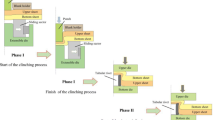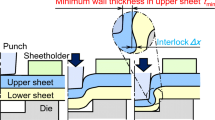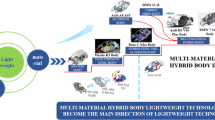Abstract
Lightweight performance and the strength of clinched joints became the key to the development of rivet-reinforced joints. In the present study, the clinching joints of AA5052 aluminum alloy were reinforced by a solid rivet and tubular rivets with wall thicknesses of 1 mm, 1.5 mm and 2 mm, to evaluate the effect of the wall thickness on the performance of the rivet-reinforced joints. The rivet-reinforcing method using tubular rivets proved to be pronounced for increasing the energy absorption and improving the strength of the clinched joint. In the experiment, compared with the conventional mechanical clinched joint, the average shearing strength of the rivet-reinforced joint with the tubular rivet of 1.5 mm wall thickness was increased from 1608.13 to 3514.5 N, and the energy absorption of the rivet-reinforced joint with the tubular rivet of 1 mm wall thickness was increased from 0.699 to 3.894 J. In terms of lightweight evaluation performance, the rivet-reinforced joint with a 1 mm wall thickness tubular rivet offered excellent results in automobile light weighting compared with the other types of rivet-reinforced joints, and the lightweight evaluation values were \({R}_{1.0}=10.494\,\text{kN/g}\) and \({W}_{1.0}=2.159\,\text{J/g}\).















Similar content being viewed by others
References
Chen C, Zhao S, Han X, Wang Y, Zhao X (2017) Investigation of flat clinching process combined with material forming technology for aluminum alloy. Materials 10(12):1433. https://doi.org/10.3390/ma10121433
Shi C, Yi RX, Chen C, Peng H, Ran XK, Zhao SD (2020) Forming mechanism of the repairing process on clinched joint. J Manuf Process 50:329–335. https://doi.org/10.1016/j.jmapro.2019.12.025
Chen C, Li YX, Zhai ZY, Zhao SD, Zhang P, Huang MH, Li YB (2019) Comparative investigation of three different reforming processes for clinched joint to increase joining strength. J Manuf Process 45:83–91. https://doi.org/10.1016/j.jmapro.2019.06.009
He X (2017) Clinching for sheet materials. Sci Technol Adv Mater 18(1):381–405. https://doi.org/10.1080/14686996.2017.1320930
He X, Liu F, Xing B, Yang H, Wang Y, Gu F, Ball A (2014) Numerical and experimental investigations of extensible die clinching. Int J Adv Manuf Technol 74(9–12):1229–1236. https://doi.org/10.1007/s00170-014-6078-y
Lei L, He XC, Yu TX, Xing BY (2019) Failure modes of mechanical clinching in metal sheet materials. Thin Wall Struct 144:106281. https://doi.org/10.1016/j.tws.2019.106281
Lambiase F (2015) Joinability of different thermoplastic polymers with aluminium AA6082 sheets by mechanical clinching. Int J Adv Manuf Technol 80(9–12):1995–2006. https://doi.org/10.1007/s00170-015-7192-1
Eshtayeh MM, Hrairi M (2016) Recent and future development of the application of finite element analysis in clinching process. Int J Adv Manuf Technol 84(9–12):2589–2608. https://doi.org/10.1007/s00170-015-7781-z
Chen C, Zhang H, Ren X, Wu J (2021) Investigation of flat-clinching process using various thicknesses aluminum alloy sheets. Int J Adv Manuf Technol 114(7):2075–2084. https://doi.org/10.1007/s00170-021-06981-z
Chen C, Han X, Zhao S, Xu F, Zhao X, Ishida T (2017) Influence of sheet thickness on mechanical clinch–compress joining technology. Proc Inst Mech Eng Part E J Process Mech Eng 232(6):662–673. https://doi.org/10.1177/0954408917735717
Chen C, Zhao SD, Han XL, Cui MC, Fan SQ (2016) Optimization of a reshaping rivet to reduce the protrusion height and increase the strength of clinched joints. J Mater Process Technol 234:1–9. https://doi.org/10.1016/j.jmatprotec.2016.03.006
Chen C, Zhao SD, Cui MC, Han XL, Fan SQ (2016) Mechanical properties of the two-steps clinched joint with a clinch-rivet. J Mater Process Technol 237:361–370. https://doi.org/10.1016/j.jmatprotec.2016.06.024
Chen C, Han XL, Zhao SD, Xu F, Zhao XZ, Ishida T (2017) Comparative study on two compressing methods of clinched joints with dissimilar aluminum alloy sheets. Int J Adv Manuf Technol 93(5–8):1929–1937. https://doi.org/10.1007/s00170-017-0650-1
Chen C, Zhang HY, Xu YQ, Wu JL (2020) Investigation of the flat-clinching process for joining three-layer sheets on thin-walled structures. Thin Wall Struct. https://doi.org/10.1016/j.tws.2020.107034
Borsellino C, Di Bella G, Ruisi V (2007) Study of new joining technique: flat clinching. In: Key engineering materials. Trans Tech Publ, pp 685–692
Mucha J, Kascak L, Spisak E (2013) The experimental analysis of forming and strength of clinch riveting sheet metal joint made of different materials. Adv Mech Eng. https://doi.org/10.1155/2013/848973
Lambiase F, Di Ilio A (2015) Mechanical clinching of metal–polymer joints. J Mater Process Technol 215:12–19. https://doi.org/10.1016/j.jmatprotec.2014.08.006
Mucha J, Witkowski W (2013) The experimental analysis of the double joint type change effect on the joint destruction process in uniaxial shearing test. Thin Wall Struct 66:39–49. https://doi.org/10.1016/j.tws.2013.01.018
Peng H, Chen C, Zhang HY, Ran XK (2020) Recent development of improved clinching process. Int J Adv Manuf Technol 110(11–12):3169–3199. https://doi.org/10.1007/s00170-020-05978-4
Chen C, Zhao SD, Cui MC, Han XL, Fan SQ, Ishida T (2016) An experimental study on the compressing process for joining Al6061 sheets. Thin Wall Struct 108:56–63. https://doi.org/10.1016/j.tws.2016.08.007
He XC, Zhao L, Yang HY, Xing BY, Wang YQ, Deng CJ, Gu FS, Ball A (2014) Investigations of strength and energy absorption of clinched joints. Comp Mater Sci 94:58–65. https://doi.org/10.1016/j.commatsci.2014.01.056
Han L, Chrysanthou A, Young KW (2007) Mechanical behaviour of self-piercing riveted multi-layer joints under different specimen configurations. Mater Design 28(7):2024–2033. https://doi.org/10.1016/j.matdes.2006.06.015
Lee CJ, Kim JY, Lee SK, Ko DC, Kim BM (2010) Design of mechanical clinching tools for joining of aluminium alloy sheets. Mater Des 31(4):1854–1861. https://doi.org/10.1016/j.matdes.2009.10.064
Lee CJ, Kim JY, Lee SK, Ko DC, Kim BM (2010) Parametric study on mechanical clinching process for joining aluminum alloy and high-strength steel sheets. J Mech Sci Technol 24(1):123–126. https://doi.org/10.1007/s12206-009-1118-5
Lambiase F (2012) Influence of process parameters in mechanical clinching with extensible dies. Int J Adv Manuf Technol 66(9–12):2123–2131. https://doi.org/10.1007/s00170-012-4486-4
Lambiase F, Di Ilio A (2012) Finite element analysis of material flow in mechanical clinching with extensible dies. J Mater Eng Perform 22(6):1629–1636. https://doi.org/10.1007/s11665-012-0451-5
Lambiase F, Di Ilio A, Paoletti A (2015) Joining aluminium alloys with reduced ductility by mechanical clinching. Int J Adv Manuf Technol 77(5–8):1295–1304. https://doi.org/10.1007/s00170-014-6556-2
Mucha J (2011) The analysis of lock forming mechanism in the clinching joint. Mater Des 32(10):4943–4954. https://doi.org/10.1016/j.matdes.2011.05.045
He XC, Zhang Y, Xing BY, Gu FS, Ball A (2015) Mechanical properties of extensible die clinched joints in titanium sheet materials. Mater Des 71:26–35. https://doi.org/10.1016/j.matdes.2015.01.005
Song Y, Yang L, Zhu G, Hua L, Liu R (2019) Numerical and experimental study on failure behavior of steel-aluminium mechanical clinched joints under multiple test conditions. Int J Lightweight Mater Manuf 2(1):72–79. https://doi.org/10.1016/j.ijlmm.2018.12.005
Chen C, Zhao S, Cui M, Han X, Ben N (2016) Numerical and experimental investigations of the reshaped joints with and without a rivet. Int J Adv Manuf Technol 88(5–8):2039–2051. https://doi.org/10.1007/s00170-016-8889-5
Chen C, Zhao SD, Han XL, Cui MC, Zhao XZ, Ishida T (2017) Experimental investigation of the mechanical reshaping process for joining aluminum alloy sheets with different thicknesses. J Manuf Process 26:105–112. https://doi.org/10.1016/j.jmapro.2017.01.015
Chen C, Fan SQ, Han XL, Zhao SD, Cui MC, Ishida T (2017) Experimental study on the height-reduced joints to increase the cross-tensile strength. Int J Adv Manuf Technol 91(5–8):2655–2662. https://doi.org/10.1007/s00170-016-9939-8
Chen C, Zhao SD, Cui MC, Han XL, Zhao XZ, Ishida T (2017) Effects of geometrical parameters on the strength and energy absorption of the height-reduced joint. Int J Adv Manuf Technol 90(9–12):3533–3541. https://doi.org/10.1007/s00170-016-9619-8
Lambiase F, Ko DC (2017) Two-steps clinching of aluminum and carbon fiber reinforced polymer sheets. Compos Struct 164:180–188. https://doi.org/10.1016/j.compstruct.2016.12.072
Chen C, Li YX, Zhang HY, Li YB, Pan Q, Han XL (2020) Investigation of a renovating process for failure clinched joint to join thin-walled structures. Thin Wall Struct. https://doi.org/10.1016/j.tws.2020.106686
Chen C, Zhang HY, Peng H, Ran XK, Pan Q (2020) Investigation of the restored joint for aluminum alloy. Metals 10(1):1–13. https://doi.org/10.3390/met10010097
Chen C, Ran XK, Pan Q, Zhang HY, Yi RX, Han XL (2020) Research on the mechanical properties of repaired clinched joints with different forces. Thin Wall Struct. https://doi.org/10.1016/j.tws.2020.106752
Abe Y, Saito T, Mori KI, Kato T (2018) Mechanical clinching with dies for control of metal flow of ultra-high-strength steel and high-strength steel sheets. Proc Inst Mech Eng Part B J Eng Manuf 232(4):644–649. https://doi.org/10.1177/0954405416683429
Abe Y, Kishimoto M, Kato T, Mori K (2009) Joining of hot-dip coated steel sheets by mechanical clinching. Int J Mater Form 2(S1):291–294. https://doi.org/10.1007/s12289-009-0446-4
Eshtayeh M, Hrairi M (2016) Multi objective optimization of clinching joints quality using Grey-based Taguchi method. Int J Adv Manuf Technol 87(1–4):233–249. https://doi.org/10.1007/s00170-016-8471-1
Lambiase F, Di Ilio A (2014) An experimental study on clinched joints realized with different dies. Thin Wall Struct 85:71–80. https://doi.org/10.1016/j.tws.2014.08.004
Funding
This research work is supported by the National Natural Science Foundation of China (Grant No. 51805416), Young Elite Scientists Sponsorship Program by CAST, Natural Science Foundation of Hunan Province (Grant No. 2020JJ5716), Natural Science Basic Research Plan in Shanxi Province of China (Grant No. 2019JQ-372), the Project of State Key Laboratory of High Performance Complex Manufacturing, Central South University (Grant No. ZZYJKT2019-01), and Huxiang High-Level Talent Gathering Project of HUNAN Province (Grant No. 2019RS1002).
Author information
Authors and Affiliations
Corresponding author
Ethics declarations
Conflict of interest
The authors declare that they have no conflict of interest.
Additional information
Technical Editor: Monica Carvalho.
Publisher's Note
Springer Nature remains neutral with regard to jurisdictional claims in published maps and institutional affiliations.
Rights and permissions
About this article
Cite this article
Ren, X., Chen, C., Ran, X. et al. Investigation on lightweight performance of tubular rivet-reinforced joints for joining AA5052 sheets. J Braz. Soc. Mech. Sci. Eng. 43, 333 (2021). https://doi.org/10.1007/s40430-021-03053-x
Received:
Accepted:
Published:
DOI: https://doi.org/10.1007/s40430-021-03053-x




